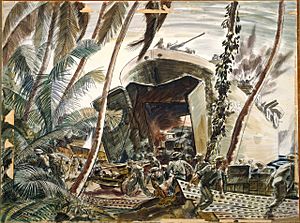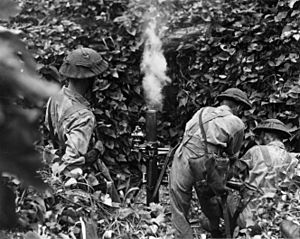Battle of the Treasury Islands facts for kids
Quick facts for kids Battle of the Treasury Islands |
|||||||
|---|---|---|---|---|---|---|---|
| Part of the Pacific Theatre of the Second World War | |||||||
 Russell Clark's painting Landing ships under fire, Treasury Island (3rd NZ Division), 27 October 1943 |
|||||||
|
|||||||
| Belligerents | |||||||
| Commanders and leaders | |||||||
| Unknown | |||||||
| Strength | |||||||
| 6,574 men 6 destroyers 32 aircraft |
231+ men 49 planes |
||||||
| Casualties and losses | |||||||
| 52 dead 174 wounded 1 destroyer damaged |
223 dead 8 POW 12 planes |
||||||
The Battle of the Treasury Islands was a fight during the Second World War. It happened between October 27 and November 12, 1943. This battle took place on the Treasury Islands, which are part of the Solomon Islands.
This battle was part of the larger Pacific War. Forces from New Zealand and the United States fought against Japanese troops. Most of the soldiers on the ground were from New Zealand's 3rd Division.
The Allied plan was to take over Mono and Stirling Islands. They wanted to build a radar station on Mono Island. Stirling Island would be a starting point for attacking Bougainville. Taking the Treasury Islands was part of a bigger Allied plan. This plan aimed to cut off Bougainville and Rabaul from Japanese support. It also aimed to remove Japanese forces from the area.
Contents
Why the Battle Happened: Allied Plans
In late 1943, the Allies were fighting in the Solomon Islands campaign. They decided to attack the Treasury Islands. This was part of their plan to cut off Japanese forces in Bougainville and Rabaul. The attack was called Operation Goodtime.
The main fighting force for this operation came from the New Zealand Army. American forces also supported them. New Zealand's 8th Infantry Brigade Group led by Brigadier Robert Row was part of this mission.
The Treasury Islands have two main islands: Mono and Stirling. They are located about 300 miles (480 km) northwest of Guadalcanal. They are also 18 miles (29 km) south of the Shortland Islands.
These islands were important for the Allies. They offered a way to move forward in the Solomons. This allowed them to avoid large groups of Japanese soldiers. The main goal was to reach the Japanese base at Rabaul. This was a key part of the larger Allied plan called Operation Cartwheel.
The islands also had a deep natural harbor called Blanche Harbour. The Allies thought this harbor would be useful. It could support their landing operations at Cape Torokina on Bougainville. Mono Island was high, which made it a good spot for a radar station. This radar would give early warnings of air and sea attacks during the Cape Torokina operation.
The Allies also hoped this attack would trick the Japanese. They wanted the Japanese to think the next Allied move would be on the Shortlands or at Buin. This was instead of the real target, Cape Torokina.
How the Battle Unfolded
The Allies started their invasion of the Treasury Islands at 6:06 AM on October 27. Eight fast transport ships were used for the operation. They also had eight LCIs, two LSTs, and three LCTs. Before the main landing, small scouting missions were carried out.
On October 27, after a short naval and air attack, the ships arrived. They started sending smaller landing craft to shore. It was raining heavily, which made it hard to see. Despite this, two destroyers, USS Philip and Pringle, fired many shells.
Two infantry battalions from New Zealand, the 29th and 36th, landed. They landed near Falamai on the southern coast of Mono Island. This was about 2 miles (3.2 km) from Blanche Harbour's entrance. At the same time, a group from the 34th Infantry Battalion landed on Stirling Island. Another group of 200 soldiers from the 34th landed north of Mono Island. They secured the area for a radar station that would be built there.
A total of 3,795 soldiers landed in the first wave. The rest of the Allied force landed over the next 20 days. The total number of troops reached 6,574 men. This was the first amphibious assault for New Zealand troops since the Gallipoli campaign in 1915. It was their second combat operation in the Pacific.
New Zealand infantry were supported by US units. These included a naval construction battalion (the 87th), a signals unit, and a coastal artillery battalion (the 198th). The artillery provided anti-aircraft fire.
The Japanese were surprised by the attack. They could not send planes to attack the landing craft until after the troops were ashore. Later on October 27, 25 Japanese dive bombers attacked two US destroyers. These were USS Cony and Philip. In the fight, 12 Japanese planes were shot down. The Cony was hit twice, killing eight of her crew and wounding 10. The destroyer had to be towed away for repairs.
Meanwhile, fighting continued on land. The Japanese resistance to the first landing was light. It was quickly overcome with only a few casualties. Within hours, a beachhead (a secure area on the beach) was set up around Falamai. Over the next few days, patrols were sent out to clear the island.
The force holding Soanotalu fought off several attacks from October 29 to November 2. One attack by about 40 Japanese soldiers was defeated. On Stirling Island, the New Zealanders faced almost no opposition. They patrolled the island and started building a base. There were a few small Japanese raids. However, Japanese air power was mostly focused on the landing at Cape Torokina, which began on November 1.
The British flag was raised over the ruins of Falamai, the islands' main town, on November 1. Civilian rule was brought back. Soldiers began "mopping up" operations. For 11 days, small fights happened as patrols searched for Japanese troops. These Japanese soldiers were mostly hiding in caves on the northern coast. These fights led to more casualties on both sides. Several groups of Japanese were killed in gunfights with New Zealand patrols.
After the Battle: What Happened Next
On November 12, the islands were declared clear of Japanese forces. However, some Japanese soldiers were still seen in the jungles until January 1944. This operation, along with a raid on Choiseul, helped to distract the Japanese Seventeenth Army. This allowed the Allies to prepare for their next big target in the Solomon Islands. The success of this battle also helped improve how future landings in the Pacific were planned.
The New Zealanders' next combat operation was the Battle of the Green Islands in early 1944. During the Treasury Islands operation, the Allies had 226 casualties. This included 40 New Zealanders killed and 145 wounded. Twelve Americans were killed and 29 wounded. The Japanese lost 223 killed and eight were captured.
Seabees (US Navy construction workers) from the 87th Naval Construction Battalion landed on October 27. One Seabee even used his bulldozer blade as a shield to attack a Japanese machine gun nest. The Seabees built 21 miles (34 km) of roads. They also set up a PT boat (patrol torpedo boat) base on Stirling Island. The rest of the 87th Naval Construction Battalion joined them on November 28.
They then started building an airstrip that was 5,600 feet (1,700 m) long and 200 feet (61 m) wide. They also built taxiways, parking areas, and a fuel storage area. This area had five 1,000-barrel (160,000 L) storage tanks for aviation gasoline. The 82nd Naval Construction Battalion took over the job in December. The 88th Naval Construction Battalion joined them in January. The airstrip was later made even longer, to 7,000 by 300 feet (2,130 by 91 m).
The 87th Naval Construction Battalion also built docks for large ocean-going ships. They used pontoon barges and timber piers connected to the shore by ramps. The first ship docked on January 30, 1944. A naval base was built with workshops and a 100-bed hospital.
PT boats based in the Treasury Islands helped protect Allied forces landing at Torokina. A radar site was set up around Soanotalu. This radar played an important part in the success of the Torokina operation. The airbase was used by medium bombers from the USAAF's 42d Bombardment Group and the U.S. Marine Corps' VMB-413. The base facilities were used by the U.S. Navy's Acorn 12.
Building the base was mostly finished by July 1944. Responsibility for the base was then given to Construction Battalion Maintenance Units (CBMU) 569 and 587. Some of the base facilities were sent to Leyte in December 1944 and January 1945. The base closed when CBMU 569 left in June 1945.
Images for kids




